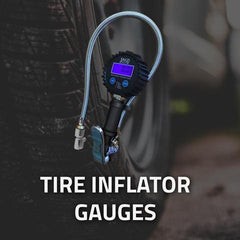Maintaining the correct tire pressure is crucial for vehicle safety, fuel efficiency, and tire longevity. While any tire pressure gauge is better than none, upgrading to a Digital Tire Pressure Gauge offers significant advantages in accuracy and ease of use. For over 35 years, JACO has been dedicated to manufacturing precision air tools, and our commitment to quality makes us a leader in tire pressure technology.
The Superiority of Digital Tire Pressure Gauges
Unlike analog gauges, a digital tire pressure gauge provides a precise, numerical readout, eliminating guesswork and parallax errors. This accuracy is paramount for ensuring your tires are inflated to the manufacturer’s recommended pressure, which directly impacts your driving experience and vehicle maintenance.
Benefits of Using a Digital Tire Pressure Gauge:
- Unmatched Accuracy: Digital gauges offer pinpoint accuracy, ensuring precise tire inflation for optimal performance and safety. This eliminates the ambiguity of reading traditional analog gauges.
- Easy-to-Read Display: The clear digital display is easy to read in any lighting conditions, a significant advantage over squinting at small markings on an analog gauge, especially in low light.
- User-Friendly Operation: Typically, digital gauges offer simple button operation for power, unit selection, and sometimes features like backlight and automatic shut-off, enhancing user convenience.
- Durability and Longevity: High-quality digital gauges, like those from JACO, are built to last, with robust construction to withstand regular use in various environments.
The Importance of Proper Tire Inflation
Whether you’re navigating city streets or tackling off-road trails, maintaining correct tire pressure is not just about comfort; it’s about safety and economy.
- Fuel Efficiency: Underinflated tires increase rolling resistance, forcing your engine to work harder and consume more fuel. A digital tire pressure gauge helps you maintain optimal inflation, saving you money at the pump.
- Enhanced Safety: Properly inflated tires provide the intended contact patch with the road, ensuring optimal braking and handling. Underinflation can lead to overheating and tire failure, while overinflation reduces grip. A precise digital tire pressure gauge minimizes these risks.
- Extended Tire Life: Incorrect tire pressure leads to uneven wear. Underinflation causes wear on the tire shoulders, while overinflation wears the center. Maintaining the correct pressure with a digital tire pressure gauge promotes even tread wear, extending the life of your tires.
- Improved Vehicle Performance: Correctly inflated tires contribute to better handling, smoother ride quality, and optimal braking performance, enhancing your overall driving experience.
JACO: Your Trusted Partner for Digital Tire Pressure Gauges
JACO has earned industry recognition for producing top-tier tire pressure gauges. Featured in publications like Car Bibles and Offroad 4×4 Nation, JACO gauges are trusted by professionals and everyday drivers alike. Our digital tire pressure gauges are engineered in Colorado and calibrated in Illinois, ensuring the highest standards of accuracy and reliability.
Choosing a digital tire pressure gauge from JACO means investing in precision, safety, and the longevity of your vehicle. Experience the JACO difference and take control of your tire maintenance today.
[
